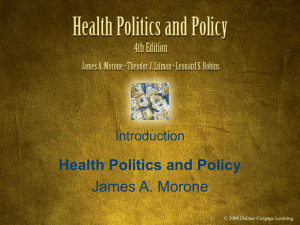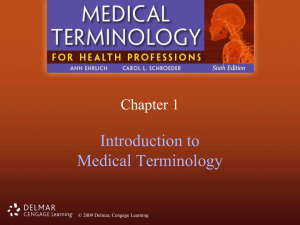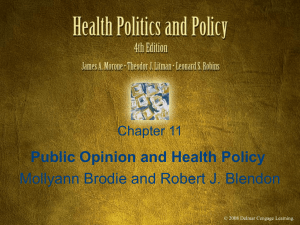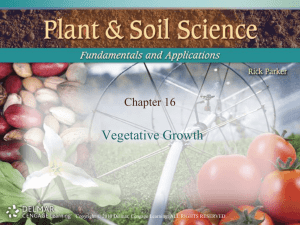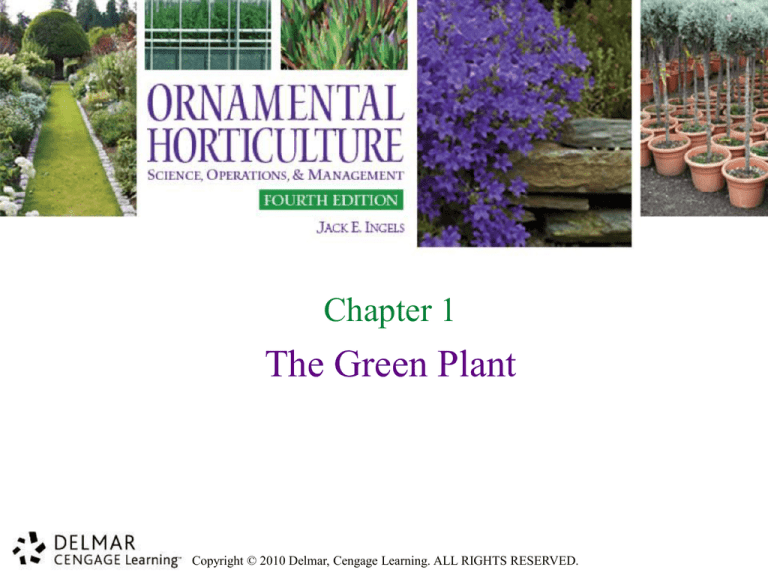
Chapter 1
The Green Plant
Copyright © 2010 Delmar, Cengage Learning. ALL RIGHTS RESERVED.
The Value of Plants in Our Lives
•
•
•
•
Produce and recycle oxygen
Capture and convert sun’s energy
Provide food products and lumber
Provide medicines, fermenting agents, dyes,
etc.
• Nurture people physically and
psychologically
Copyright © 2010 Delmar, Cengage Learning. ALL RIGHTS RESERVED.
Five Kingdoms of
the Natural World
1. Monera — one-celled bacteria, etc.
2. Protista — aquatic microorganisms
3. Fungi — defined by possession of cell
wall
4. Animals — derive nutrition from other
forms
5. Plants — derive energy from
photosynthesis
Copyright © 2010 Delmar, Cengage Learning. ALL RIGHTS RESERVED.
The Plant Kingdom
• Taxonomy
– Study of plant classification
•
•
•
•
•
•
Divisions
Classes
Orders
Families
Genera
Species
Copyright © 2010 Delmar, Cengage Learning. ALL RIGHTS RESERVED.
Tracheophyta Division
• Vascular plants
– Higher plants
• Characterized by internal conducting systems
– Xylem
– Phloem
• Most reproduce from seeds
– Coniferous
• Seeds produced in cones
Copyright © 2010 Delmar, Cengage Learning. ALL RIGHTS RESERVED.
Tracheophyta Division
• Most reproduce from seeds
– Angiospermopsida
• Flowering plants
• Seeds reproduced inside fruit from fertilized flower
• Monocots
– Single-seed leaf
• Dicots
– Two-seed leaves
Copyright © 2010 Delmar, Cengage Learning. ALL RIGHTS RESERVED.
Plant Nomenclature
• Nomenclature
– Naming of plants
• Each plant has botanical name
– “Latin binomial” name
• Combines genus and epithet
• Names may have variety and/or “cultivar”
– Short for “cultivated variety”
• Most plants also have common names
Copyright © 2010 Delmar, Cengage Learning. ALL RIGHTS RESERVED.
Parts of a Plant
• Roots
– Fibrous root
• Network of equal-sized strands
– Tap root
• Dominant central root
– Absorb water and nutrients from soil
– Anchor plants against wind and rain
– Store food products from leaves
Copyright © 2010 Delmar, Cengage Learning. ALL RIGHTS RESERVED.
Parts of a Plant
• Stems
– Conduct water and nutrients to other parts
• Principal function
• Leaves
– Major food manufacturer
– Contain chlorophyll
Copyright © 2010 Delmar, Cengage Learning. ALL RIGHTS RESERVED.
Parts of a Plant
• Flowers or cones
– Reproductive structures
• Complete flower
– Possesses all parts
• Incomplete flower
– Lacks one or more parts
• Perfect flower
– Has male and female stamens
Copyright © 2010 Delmar, Cengage Learning. ALL RIGHTS RESERVED.
The Structure of Plant Parts
• Cell
– Basic structural unit
• Millions of cells comprise each plant part
Copyright © 2010 Delmar, Cengage Learning. ALL RIGHTS RESERVED.
The Structure of Plant Parts
• Large groups of similar cells form tissues
–
–
–
–
Stems
Leaves
Roots
Seeds
• Groups of tissues form organs
Copyright © 2010 Delmar, Cengage Learning. ALL RIGHTS RESERVED.
Elements of a Plant Cell
• Protoplast
– Living matter of a cell
• Nucleus contains genetic information
• Cytoplasm
– Everything but nucleus
– Protoplast
• Cytoplasm plus nucleus
Copyright © 2010 Delmar, Cengage Learning. ALL RIGHTS RESERVED.
Elements of a Plant Cell
• Chloroplasts contain chlorophyll pigment
• Chlorophyll
– Key to photosynthesis
Copyright © 2010 Delmar, Cengage Learning. ALL RIGHTS RESERVED.
Elements of a Plant Stem
• Vascular bundles
– Convey nutrients
• Sieve elements
– Convey food produced by photosynthesis
• Activity in cambium tissue increases stem
size
Copyright © 2010 Delmar, Cengage Learning. ALL RIGHTS RESERVED.
Elements of a Plant Stem
• Buds emanate from nodes on stems
• Internode
– Space between two nodes
Copyright © 2010 Delmar, Cengage Learning. ALL RIGHTS RESERVED.
Elements of a Plant Leaf
• Leaf veins
– Important to classification
• Stomates
– Leaf pores
– Water escapes through open stomates via transpiration
– Closed stomates diminish transpiration
• Waxy cuticles make parts of leaves
waterproof
Copyright © 2010 Delmar, Cengage Learning. ALL RIGHTS RESERVED.
Leaf Color
• Result of pigment within cells
• Chlorophyll
– Most common pigment
– Causes green coloration
• Xanthophyll causes yellow coloration
• Carotene causes orange coloration
• Anthocyanins cause red coloration
Copyright © 2010 Delmar, Cengage Learning. ALL RIGHTS RESERVED.
Roots and Seeds
• Apical meristem
– Section that elongates
• Meristem protected at base by root cap
• Root hairs
– Most absorbent part
• Seed contains embryo
– Protected by seed coats or pericarps
Copyright © 2010 Delmar, Cengage Learning. ALL RIGHTS RESERVED.
Juvenility and Maturity in Plants
• Juvenility
– State when plant cannot flower
• Maturity
– State when plant can flower
Copyright © 2010 Delmar, Cengage Learning. ALL RIGHTS RESERVED.
Major Plant Processes
•
•
•
•
Photosynthesis
Respiration
Transpiration
Translocation
Copyright © 2010 Delmar, Cengage Learning. ALL RIGHTS RESERVED.
What Plants Need for Growth
•
•
•
•
•
Soil
Atmosphere
Water
Light
Temperature
Copyright © 2010 Delmar, Cengage Learning. ALL RIGHTS RESERVED.
How Light Nurtures Plants
• Threshold value
– Minimum light required
• Plants grow toward light via tropism
• Plants follow light intensity via
phototropism
• Auxin
– Growth stimulant plants produce
Copyright © 2010 Delmar, Cengage Learning. ALL RIGHTS RESERVED.
How Light Nurtures Plants
• Photoperiodism
– Response of plants to light changes
• Long-day plants require extended light
• Short-day plants only flower in limited light
• Day-neutral plants not limited
Copyright © 2010 Delmar, Cengage Learning. ALL RIGHTS RESERVED.


